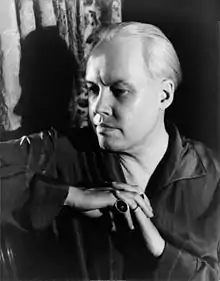Firecrackers. A Realistic Novel
Firecrackers. A Realistic Novel is a 1925 novel by American author Carl Van Vechten.[1] It is one of several fictional works published that same year which assayed the temerity and hedonism of the Jazz Age including F. Scott Fitzgerald's The Great Gatsby and Anita Loos' Gentlemen Prefer Blondes.[2]
.jpg.webp) Cover of the first edition in 1925 | |
| Author | Carl Van Vechten |
|---|---|
| Country | United States |
| Language | English |
| Genre | Novel |
| Published | 1925 (Knopf) |
| Media type | Print (hardcover & paperback) |
| Pages | 246 |
Van Vechten dedicated this novel to his friend James Branch Cabell. The book is considered to be the fourth entry in a series about New York's "Upper Bohemians." Firecrackers chronicles the further adventures of characters—such as Paul Moody, Gareth Johns, Ella Nattatorrini, and Edith Dale—who appeared in Vechten's earlier works, The Blind Bow-Boy (1923) and The Tattooed Countess (1924).[1][3]
Synopsis
You must think of a group of people in terms of a packet of firecrackers. You ignite the first cracker and the flash fires the fuse of the second, and so on, until, after a series of crackling detonations, the whole bunch has exploded, and nothing survives but a few torn and scattered bits of paper, blackened with powder.
During 1924, a blasé coterie of pleasure-seeking sophisticates are inordinately excited by a handsome and athletic newcomer to their social circle, Gunnar O'Grady, "a youth with the appearance of a Greek Adonis."[1] Alternately seeking and avoiding their attentions, this enigmatic individual drifts through a series of menial vocations including furnace repairman, florist, waiter, and acrobat.
O'Grady becomes an object of sexual fascination to many within the circle, including a precocious young girl, a thrill-seeking wife, and a bored husband. Tensions escalate as various persons within the coterie vie for O'Grady's companionship, and O'Grady finds his own desires stymied.
Reception
Writer F. Scott Fitzgerald praised the novel in his personal correspondence to Van Vechten.[5] In a letter dated July 27, 1925, Fitzgerald wrote: "I like [Firecrackers] best of your four novels—It seems to me that this rather than The Tattooed Countless is your true line of genius. In [the character of] Campaspe, for example, you suggest so much more than you say—she is the embodiment of New York, mysterious and delicate and entirely original."[5]
References
- The New York Times 1925.
- Fitzgerald 2003, p. 15.
- Lueders 1965, p. 88.
- Van Vechten 1925, p. 126.
- Lueders 1965, p. 89.
Bibliography
- Fitzgerald, F. Scott (April 2003) [1945]. "Echoes of the Jazz Age". In Wilson, Edmund (ed.). The Crack-Up. New Directions. ISBN 978-0-8112-1820-7.CS1 maint: ref=harv (link)
- Lueders, Edward (1965). Bowman, Sylvia E. (ed.). Carl Van Vechten. Twayne's United States Authors Series. New York: Twayne Publishers.CS1 maint: ref=harv (link)
- "New York of 1924 in a New Van Vechten Novel". The New York Times. August 9, 1925. pp. 38–39. Retrieved February 2, 2019.
- Van Vechten, Carl (1925). Firecrackers. A Realistic Novel. New York: Alfred A. Knopf. ISBN 978-1-59569-068-5.CS1 maint: ref=harv (link)
